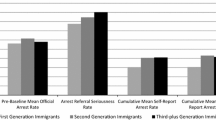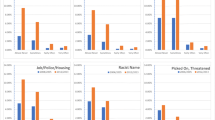Abstract
Purpose
Although recent research on crime and violence among immigrants suggests a paradox—where immigrants are more socially disadvantaged yet less likely to commit crime—previous research is limited by issues of generalizability and assessment of the full depth of antisocial behavior.
Methods
We surmount these limitations using data from waves I and II of the National Epidemiologic Survey on Alcohol and Related Conditions (NESARC) and compare immigrants (N = 7,320) from Asia, Africa, Europe, and Latin America to native-born Americans (N = 34,622) with respect to violent and nonviolent forms of antisocial behavior.
Results
After controlling for an extensive array of confounds, results indicate that immigrants are significantly less antisocial despite being more likely to have lower levels of income, less education, and reside in urban areas. These findings hold for immigrants from major regions of the world including Africa, Asia, Europe, and Latin America.
Conclusions
This study confirms and extends prior research on crime and antisocial behavior, but suggests that it is premature however to think of immigrants as a policy intervention for treating high crime areas.



Similar content being viewed by others
References
Borjas GJ (2011) Poverty and program participation among immigrant children. The Future Child 21:247–266
Huston AC, Bentley AC (2010) Human development in society context. Annu Rev Psychol 61:411–437
Watkins AM, Melde C (2009) Immigrants, assimilation, and perceived school disorder: an examination of the “other” ethnicities. J Crim Justice 37:627–635
Mears DP (2000) The immigration-crime nexus: toward an analytic framework for assessing and guiding theory, research, and policy. Sociol Perspect 44(1):1–19
Zatz MS, Smith H (2012) Immigration, crime, and victimization: rhetoric and reality. Annu Rev Law Soc Sci 8:141–159
Buckler K, Swatt ML, Salinas P (2009) Public views of illegal migration policy and control strategies: a test of the core hypotheses. J Crim Justice 37:317–327
Higgins GE, Gabbidon SL, Martin F (2010) The role of race/ethnicity and race relations on public opinion related to the immigration and crime link. J Crim Justice 38:51–56
Papachristos AV, Hureau DM, Braga AA (2013) The corner and the crew: the influence of geography and social networks on gang violence. Am Sociol Rev 78:417–447
Rose DR, Clear TR (1998) Incarceration, social capital, and crime: implications for social disorganization theory. Criminology 36:441–480
Shaw CR, McKay HD (1942) Juvenile delinquency and urban areas. University of Chicago Press, Chicago
Taylor R (1997) Social order and disorder of street blocks and neighborhoods: ecology, microecology and the systemic model of social disorganization. J Res Crime Delinquency 34:113–155
Wilson WJ (1987) The truly disadvantaged. University of Chicago, Chicago
Allen J, Cancino JM (2012) Social disorganization, Latinos and juvenile crime in the Texas borderlands. J Crim Justice 40:152–163
MacDonald JM, Saunders J (2012) Are immigrant youth less violent? Specifying the reasons and mechanisms. ANNALS Am Acad Polit Soc Sci 641:125–147
Martinez R, Stowell JI (2012) Extending immigration and crime studies: national implications and local settings. ANNALS Am Acad Polit Soc Sci 641:174–191
Tapia M (2010) Untangling race and class effects on juvenile arrests. J Crim Justice 2010(38):255–265
Sampson RJ (2008) Rethinking crime and immigration. Contexts 7:28–33
Hagan J, Palloni A (1999) Sociological criminology and the mythology of Hispanic immigration and crime. Soc Probl 46:617–632
Martinez R, Lee MT (2000) On immigration and crime. In: LaFree G, Bursick RJ Jr (eds) Criminal justice 2000: The changing nature of crime. National Institute of Justice, Washington, DC
Lee MT, Martinez R, Rosenfeld R (2001) Does immigration increase homicide? Negative evidence from three border cities. The Sociol Q 42:559–580
Harris CT, Feldmeyer B (2013) Latino immigration and White, Black, and Latino violent crime: a comparison of traditional and non-traditional immigrant destinations. Soc Sci Res 42:202–216
Bui H (2009) Parent-child conflicts, school troubles, and differences in delinquency across immigration generations. Crime & Delinquency 55(3):412–441
Ousey GC, Kubrin CE (2009) Exploring the connection between immigration and violent crime rates in U.S. cities, 1980–2000. Soc Probl 56:447–473
Williams RL, Weiss HE, Adelman RM, Jarett C (2005) The immigration-crime relationship: evidence across U.S. metropolitan areas. Soc Sci Res 34:757–780
Lee MT, Martinez R (2009) Immigration reduces crime: an emerging scholarly consensus. In: McDonald WF (ed) Immigration, crime and justice. Emerald Group, Bingley, UK, pp 3–16
MacDonald JM, Hipp JR, Gill C (2013) The effects of immigrant concentration on changes in neighborhood crime rates. J Quant Criminol 29:191–215
Wadsworth T (2010) Is immigration responsible for the crime drop? An assessment of the influence of immigration on crime between 1990 and 2000. Soc Sci Q 91:531–553
Shihaeh ES, Barranco RE (2000) Latino employment and black violence: the unintended consequence of U.S. immigration policy. Soc Forces 88:393–1420
Shihadeh ES, Barranco RE (2010) Leveraging the power of the ethnic enclave: residential instability and violence in latino communities. Sociol Spectr 30:249–269
Breslau J, Borges G, Saito N, Tancredi DJ, Benjet C, Hinton L et al (2011) Migration from Mexico to the United States and conduct disorder: a cross-national study. Arch Gen Psychiatry 68:1284–1293
Correia ME (2010) Determinants of attitudes toward police of Latino immigrants and non-immigrants. J Crim Justice 38:99–107
Rennison CM (2010) An investigation of reporting violence to the police: a focus on Hispanic victims. J Crim Justice 38:390–399
Charles CZ (2006) Won’t you be my neighbor? Race, class, and residence in Los Angeles. Russell Sage Foundation, New York
Grant BF, Dawson DA, Stinson FS, Chou PS, Kay W, Pickering R (2003) The Alcohol Use Disorder and Associated Disabilities Interview Schedule-IV (AUDADIS-IV): reliability of alcohol consumption, tobacco use, family history of depression and psychiatric diagnostic modules in a general population sample. Drug Alcohol Depend 71:7–16
Grant BF, Hartford T, Dawson DA, Chou PS, Pickering R (1995) The Alcohol Use Disorder and Associated Disabilities Interview Schedule (AUDADIS): reliability of alcohol and drug modules in the general population sample. Drug Alcohol Depend 39:37–44
Hasin D, Carpenter KM, McCloud S, Grant BF (1997) The alcohol use disorders and associated disabilities interview schedule (AUDADIS): reliability of alcohol and drug modules in a clinical sample. Drug Alcohol Depend 44:133–141
Blanco C, Grant J, Petry NM, Simpson HB, Alegria A, Liu SM, Hasin D (2008) Prevalence and correlates of shoplifting in the United States: results from the National Epidemiologic Survey on Alcohol and Related Conditions (NESARC). Am J Psychiatry 165:905–913
Vaughn MG, Fu J, DeLisi M, Beaver KM, Perron BE, Howard MO (2010) Criminal victimization and comorbid substance use and psychiatric disorders in the United States: results from the NESARC. Ann Epidemiol 20:281–288
Vaughn MG, DeLisi M, Gunter T, Fu Q, Beaver KM, Perron BE, Howard MO (2011) The severe 5 %: a latent class analysis of the externalizing spectrum in the United States. J Crim Justice 39:75–80
StataCorp. (2011) Stata Statistical Software: Release 12. StataCorp LP, College Station, TX
Conflict of interest
None.
Author information
Authors and Affiliations
Corresponding author
Rights and permissions
About this article
Cite this article
Vaughn, M.G., Salas-Wright, C.P., DeLisi, M. et al. The immigrant paradox: immigrants are less antisocial than native-born Americans. Soc Psychiatry Psychiatr Epidemiol 49, 1129–1137 (2014). https://doi.org/10.1007/s00127-013-0799-3
Received:
Accepted:
Published:
Issue Date:
DOI: https://doi.org/10.1007/s00127-013-0799-3




